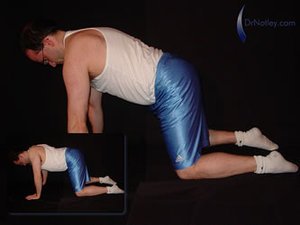The shoulder is one of the most common areas that I treat. Poor scapular stability is one reason for shoulder pain. Serratus anterior seems to be the culprit. Serratus anterior has forgotten how to works (let’s call this serratus anterior amnesia). The Quadruped serratus push up is one of the first 2 exercises I used to teach the serratus anterior get working. The other exercise is the prone thoracic extension
Quadruped Serratus Anterior Pushup
Muscles Exercised
- Serratus Anterior and other Scapular stabilizers
- Rotator cuff muscles (indirectly)
Start Position
- On your hands and knees
- The further back your knees are the more intense the exercise. The further your shoulders are behind your wrist the less intense the exercise
- Make sure your back stays neutral
- Elbows stay straight at all times.
- Fingers spread and weight evenly distributed across the hand
- Head looking straight down
- “Brace” the lumbar spine.
*note* The image shown is an old picture. I would ideally like to see a more neutral spine.
Finish position
- Keeping your arms straight, lift the upper back and head away from the floor. The neck should retract. Keep the nose pointing down to the ground.
- Imagine you are driving your hands through the floor
- Your shoulder blades will spread apart .
- Do not round your shoulders or back.
- Hold this position.
*note* The images shows my upper back rounded. This is something that I would make sure to be corrected.
Common errors
- Bending elbows to bring shoulder blades together
- Rounding lower back or shoulders when going to the finish position.
- Shoulder blade winging away from the rib cage. If this is happening serratus anterior and the scapular stabilizers are not working so you should reduce the intensity.
Progressions
- Take one hand off the floor and sweep it forwards and backwards or side to side.
- Take a weight plate or kettlebell and slide it forwards, backwards, side to side or randomly around. Make sure to prevent the shoulder blade to winging.
- Crawling
I hope you enjoyed this
Dr Notley
Helping people Movement Better, Feel Better, Perform Better
Originally posted on May 17, 2022 @ 4:37 pm

